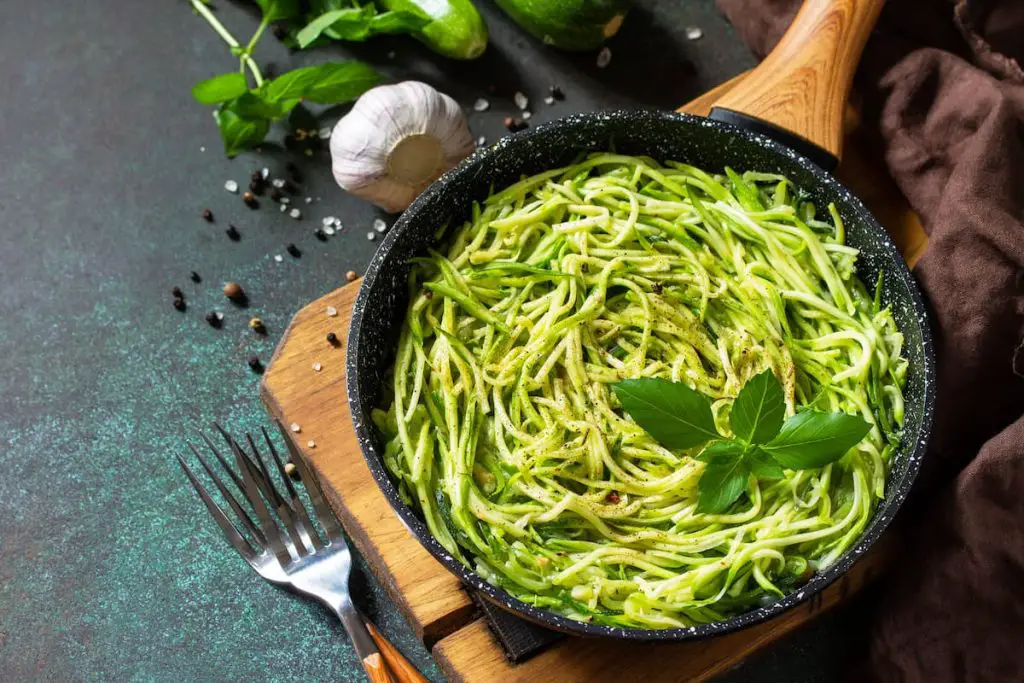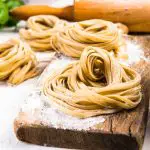Freezing Zoodles: 4 Easy Steps to Freeze Zucchini Noodles
You have likely discovered the joy of zucchini noodles, often referred to as zoodles. Zoodles are a great, healthy alternative to noodles for any lunch or dinner plate. Preparing zoodles, however, can be a lengthy process due to all that shredding, so you may be inclined to ask – if I make a big batch of zoodles, can I freeze them?
You can freeze zoodles when you have adequately prepared them first. While frozen zoodles may lose some flavor and texture during the freezing process, you can save them in the freezer for up to a year if you prepare them properly.
So, let’s get into the details and discuss what zoodles are, how to prepare them, and the 4-step freezing process you’ll want to do in order to freeze zoodles for maintaining the best taste and quality. I’ll also teach you how to defrost your zoodles to maintain their texture and taste.

What Are Zoodles?
Zoodles are a fun name for zucchini noodles. They are a popular choice of alternative pasta that is both wheat and grain-free. Many gluten-free and vegan people enjoy zoodles as an alternative pasta that meets their health requirements.
Additionally, people trying to add more vegetables to their diet and cut down on processed foods may choose zoodles over noodles.
Zoodles take on the flavor of whatever they are mixed with, making them a delicious choice to pair with various pasta sauces. People use zoodles in pasta dishes, stir fry, and side dishes. Zucchini noodles or zoodles are delicious, and they are easy to make and prepare.
Making Zoodles To Freeze
There are a few different ways to make zoodles. Each type of zoodle preparation has its advantages and disadvantages regarding the tool used, time, and labor required. Some of the easiest ways to prepare zoodles are with a spiralizer, a vegetable peeler, or a mandoline.
The good news is that no matter which of these ways you choose to make your zoodles they will be perfect for storing in the freezer.

Making Zoodles With a Spiralizer
A spiralizer is one of the most accessible options for preparing zoodles. There are both handheld spiralizers and automated spiralizers. The advantage of a handheld spiralizer is that it is straightforward to use and takes up very little storage space.
In addition, these fantastic kitchen tools make other tasks such as grating cheese, slicing onions, mincing garlic, and creating french fries simple.
You can try this Briefton’s 5 Blade Spiralizer from Amazon.com for the perfect zucchini noodles. It has five different blades you can use to get creative with the shape and thickness of your zoodles and other ingredients.
Another option is an automated spiralizer. You may try the KitchenAid Spiralizer Attachment from Amazon.com if you already have a KitchenAid mixer. This automated spiralizer takes away the labor of spiraling the zucchini yourself, and you can have heaps of faux-noodles in seconds! This attachment is a great bonus if you are someone who makes a lot of zoodles and/or cooks a lot.
However, an automated spiralizer is expensive and requires more storage space in your kitchen. So, this attachment is only a worthwhile purchase if you make zoodles often or are looking to make them relatively quickly.
Using a Peeler To Make Zoodles
Another option for making your zoodles is simply using a peeler. Depending on how thin or thick you want your zoodles, you can experiment with different peelers.
If you do not already have a vegetable peeler, you can purchase this Symgila Kitchen Peeler from Amazon.com. It is an affordable option and great to have in your kitchen for all your vegetable peeling purposes. This one comes with three different blades so that you can experiment with different ones for your zoodles.
A vegetable peeler is an excellent option because you likely already have one in your kitchen.
Additionally, it is a small tool and easy to wash and store. The disadvantage of using a peeler is that it is much slower than an automated tool such as the spiralizer. It is a cheap and easy tool to use, but it will require the most time to prepare your zoodles.
Using a Mandoline Will Make Thicker Zoodles
A mandoline is similar to a peeler, but mandoline zoodles will be a bit thicker.
Check out this handy T-GOGO 10-in-one Mandoline (available on Amazon.com) to make flat, thicker zoodles. This mandoline has ten different blades and a detachable container that snaps on the bottom, making slicing anything quick and straightforward. You can also experiment with different blade styles to see which you prefer.
A mandoline is a great option to make your zoodles quicker. It does require more storage space and can be a bit difficult to clean. However, it’s useful for more than zucchini, and it’ll make chopping, grating, and mincing anything a piece of cake!
How To Freeze & Thaw Zoodles (4 Steps)
Once you have spiralized or peeled your zucchini, you have your zoodles! Now you have to decide if you are cooking all of them or if you want to freeze some for later use.
If you made a large batch of zucchini noodles, you might opt to freeze some or all of them. Freezing zoodles is an excellent choice since you can go through the peeling or spiralizing process just once and store up lots of zoodles for later use. Freezing zoodles eliminates preparation work for later meals.
Unfortunately, you cannot just throw your zoodles into a bag and put them in the freezer. You need to take several steps to prepare your zoodles if you don’t want them to become bland and mushy.

Here’s how to properly freeze Zoodles and thaw them to eat:
- Add salt and knead your zoodles.
- Drain & dry your zucchini noodles.
- Freeze your Zoodles.
- Defrost your zoodles before eating them.
These steps help ensure that your zoodles do not turn soggy after defrosting them. They also help ensure that the zoodles do not lose texture or flavor if you freeze them for several months.
Use the following tips to ensure that your zoodles are correctly stored and freeze without losing texture and flavor. If you follow these tips, you can keep your zoodles in the freezer for a year without sacrificing quality!
1. Add Salt and Knead The Zoodles
The first thing you need to do to your zoodles is place them in a bowl and lightly salt them. Sprinkle one tablespoon of salt over your zoodles. The salt helps to preserve the texture of the zoodles while they are frozen.
Use your hands to knead and mix the salt into the zoodles gently. You want to make sure that all of your zoodles are salted. You will be kneading them for about 3 minutes. You will know that they are ready when you feel them slightly harden. During the kneading process, the zoodles will release a fair amount of moisture, and there will be water in the bowl.
2. Drain & Dry Your Zoodles
The next step is to drain and dry your zoodles. Removing as much excess moisture as possible is very important for the freezing process. It helps preserve texture and flavor and ensures that the zoodles do not turn soggy upon defrosting. To dry your zoodles, place a paper towel or preferably a cloth in a colander. Dump your zoodles into the colander with the towel.
Let the zoodles sit in the colander with the cloth for about five minutes. After letting the fabric absorb some of the liquid, pick up the towel with the zoodles and gently squeeze the water with your hands. Once you have squeezed out the excess juice from your zoodles, you will set them out to dry.
Lay your zoodles out on a dry cloth or paper towel. Spread them out a bit so they are not on top of each other. Leave them to dry for approximately one hour. The more you allow them to dry, the better they will taste after freezing and defrosting them. Excess moisture makes them soggy upon defrosting and is what you want to avoid.
3. Freeze your Zoodles
After the drying process, your zoodles are now ready to be stored and frozen.
Place your zucchini noodles in freezer bags and put them in the freezer. Make sure to separate your zoodles into different-sized bags for portioning, and do not squeeze them together too tightly. Push the air out of the bag before sealing it.
Check to make sure you have closed the bag entirely for an airtight seal.

If you want to be extra organized, you can write the date you freeze the zoodles on each bag. Marking your bags will help you track how long they have been frozen and when you should defrost them. Try to defrost and use your zoodles within one year of freezing them.
4. Defrost Your Zoodles Before Eating Them
When you are ready to defrost your zoodles, you can defrost them quickly and easily with a strainer bowl or a steaming basket. Place your frozen zucchini noodles in a strainer bowl or steaming basket and set it over boiling water. Your zoodles will be soft and ready to cook in about one minute!
Note: Make sure not to leave them to defrost for too long, or they will turn into a mushy mess.
Final Thoughts
When you are freezing your zoodles, remember the following tips:
- Prepare your zoodles for freezing by kneading them with salt.
- Dry your zoodles out as much as possible before freezing them to avoid sogginess.
- Squeeze all the air out of the bags before freezing your zoodles. Make sure to seal the bag tightly.
- Your zoodles will be safe for consumption for up to a year when frozen.
Using these tips and tricks for preparing and freezing your zucchini noodles, you can be on your way to many delicious zoodle-based meals. The best part is they will require very little preparation!






